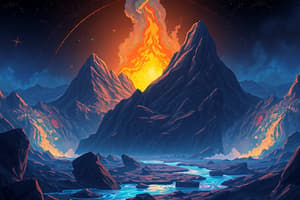Podcast
Questions and Answers
What is mining primarily concerned with?
What is mining primarily concerned with?
- Mineral extraction (correct)
- Agricultural production
- Water conservation
- Forest management
Which type of mining is most commonly used to extract gravel and sand?
Which type of mining is most commonly used to extract gravel and sand?
- Surface mining
- Open-pit mining (correct)
- Dredging
- Strip mining
What is the main advantage of strip mining compared to other types of surface mining?
What is the main advantage of strip mining compared to other types of surface mining?
- It requires less equipment and machinery
- It is less destructive to the environment
- It enables continuous mining of deposits (correct)
- It allows for deeper mineral extraction
What is primarily involved in the process of dredging?
What is primarily involved in the process of dredging?
Why is underground mining considered more dangerous than surface mining?
Why is underground mining considered more dangerous than surface mining?
What is the purpose of mineral processing?
What is the purpose of mineral processing?
Which technique is NOT typically used in surface mining?
Which technique is NOT typically used in surface mining?
What is sampling in the context of mining?
What is sampling in the context of mining?
What is the primary reason for the Philippines' richness in mineral resources?
What is the primary reason for the Philippines' richness in mineral resources?
Which type of mineral resource is more abundant and less expensive than metallic ores?
Which type of mineral resource is more abundant and less expensive than metallic ores?
What is the main process responsible for the formation of the majority of ore deposits?
What is the main process responsible for the formation of the majority of ore deposits?
In which environment do weathering processes occur most effectively?
In which environment do weathering processes occur most effectively?
How is crude oil typically recovered for use?
How is crude oil typically recovered for use?
Which of the following substances is a component of both crude oil and natural gas formations?
Which of the following substances is a component of both crude oil and natural gas formations?
What happens during magmatic processes in mineral formation?
What happens during magmatic processes in mineral formation?
Natural gas can be liquefied through which of the following processes?
Natural gas can be liquefied through which of the following processes?
Study Notes
Mineral Resources Overview
- The Philippines is rich in mineral resources due to its location in the Pacific Ring of Fire.
- Mineral resources are non-renewable and serve as essential raw materials for various industries.
Types of Mineral Resources
- Nonmetallic Mineral Resources:
- More abundant and less expensive than metallic ores.
- Metallic Mineral Resources:
- Formed by magmatic, hydrothermal, sedimentary, and weathering processes.
Formation Processes of Mineral Deposits
- Magmatic Processes:
- Involve solidification of magma to create igneous rocks and mineral deposits.
- Hydrothermal Processes:
- Hot water dissolves metals from rocks or magma, leading to ore deposit formation when metal-bearing solutions precipitate.
- Sedimentary Processes:
- Result from chemical precipitation in aqueous environments.
- Weathering Processes:
- Occur in high rainfall areas, altering the landscape and contributing to mineral formation.
Key Mineral Resources
- Coal:
- A hard, black rock-like substance composed of carbon, hydrogen, oxygen, nitrogen, and sulfur.
- Crude Oil:
- Flammable liquid made up of hydrocarbons, obtained by drilling through non-porous rock.
- Natural Gas:
- Found alongside coal and oil, can be liquified through complex processes.
Mining Techniques
- Mining Definition:
- The extraction of minerals from a natural rock or sediment containing valuable minerals.
Surface Mining
- General Process:
- Involves removing soil and rocks covering ore deposits, frequently using blasting.
- Open-Pit Mining:
- Common method creating large holes in the ground for resources like gravel and sand.
- Strip Mining:
- Removes thin strips of overburden above deposits, depositing waste behind.
- Dredging:
- Extracts materials from underwater bodies like rivers and lakes.
Underground Mining
- Extracts minerals beneath the earth's surface via tunnels.
- More dangerous and expensive compared to surface mining due to the use of explosives.
Mineral Processing
- A systematic process to extract, refine, and prepare minerals for human use.
- Sampling:
- Involves taking a portion of material for analysis.
- Analysis:
- Evaluates valuable components in ores for effective resource management.
Environmental Impact
- Awareness of the need to prevent or lessen environmental impacts resulting from mineral resource exploitation is critical.
Studying That Suits You
Use AI to generate personalized quizzes and flashcards to suit your learning preferences.
Description
Explore the vital minerals that contribute to society and learn about their extraction and processing methods. This quiz also discusses the environmental impacts of mining practices and ways to mitigate them. Test your knowledge on mineral resources and their significance in the Philippines.



